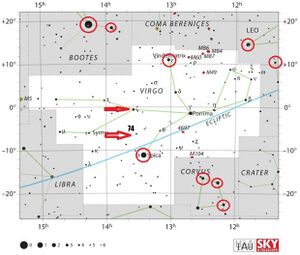Apa: Difference between revisions
No edit summary |
(The description itself has been cleared) |
||
| (2 intermediate revisions by one other user not shown) | |||
| Line 1: | Line 1: | ||
{{DISPLAYTITLE:Āpa ()}} |
{{DISPLAYTITLE:Āpa ()}} |
||
[[File:0048 apa and apavatsapaperVII Fig2.jpeg|thumb|The stars identified by Shylaja and Pai (2019), their Table 2, are marked with red circles on the map of Virgo. The two arrows correspond to Apamvatsa and Apa. The original chart by IAU and Sky & Telescope magazine (Roger Sinnott & Rick Fienberg) is from Creative Commons.]] |
|||
Āpa, |
Āpa, always named along with Apavatsa, is an Indian star name in Early Modern times. The only indication of the position is [[Apamvatsa]] is 5° to the north of [[Chitra]] ([[Spica]]) and Apa is further 6° to the north, so Apa is 11° north of Spica. No information on magnitudes is preserved.<ref>B. S. Shylaja and Venketeswara Pai (2019). Āpa and Apāṃvatsa – enigmatic stars catalogued in Sūryasiddhānta, J. Astrophys. Astr. (2019) 40:48, Indian Academy of Sciences</ref> The coordinates agree fairly well with Zeta Virginis. |
||
==Concordance, Etymology, History== |
==Concordance, Etymology, History== |
||
Āpa means water. It is always listed with the other star Apamvatsa, meaning the 'offspring of Apa', as seen in many texts , the earliest being Suryasiddhanata. Candraśekhara (19th century) lists these two terms a single phrase, confusing that Apa is identified with its offspring. |
|||
===Origin of Constellation === |
===Origin of Constellation === |
||
| Line 12: | Line 12: | ||
==Religion/ Tales/ Mythology== |
==Religion/ Tales/ Mythology== |
||
mnemonic tales and cultural significance |
mnemonic tales and cultural significance: No mythological stories are associated with this star |
||
==Weblinks== |
==Weblinks== |
||
Latest revision as of 16:42, 1 October 2025
Āpa, always named along with Apavatsa, is an Indian star name in Early Modern times. The only indication of the position is Āpaṃvatsa (अपऻऺवत्स) is 5° to the north of Citrā (चित्रा) (Spica) and Apa is further 6° to the north, so Apa is 11° north of Spica. No information on magnitudes is preserved.[1] The coordinates agree fairly well with Zeta Virginis.
Concordance, Etymology, History
Āpa means water. It is always listed with the other star Apamvatsa, meaning the 'offspring of Apa', as seen in many texts , the earliest being Suryasiddhanata. Candraśekhara (19th century) lists these two terms a single phrase, confusing that Apa is identified with its offspring.
Origin of Constellation
The text Sūryasiddhānta is considered as an authority from the 8th to the 19th century CE, but the author(s) remain unknown. Its date is estimated to the 4th or 5th century. It contains a chapter with lists of coordinates and names of stars, which allows for identifications.
Transfer and Transformation of the Constellation
Religion/ Tales/ Mythology
mnemonic tales and cultural significance: No mythological stories are associated with this star
Weblinks
References
- References (general)
- ↑ B. S. Shylaja and Venketeswara Pai (2019). Āpa and Apāṃvatsa – enigmatic stars catalogued in Sūryasiddhānta, J. Astrophys. Astr. (2019) 40:48, Indian Academy of Sciences





